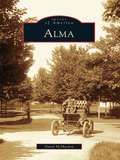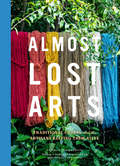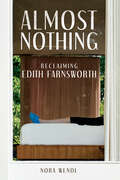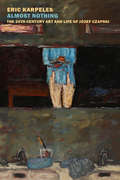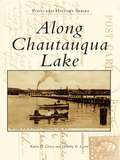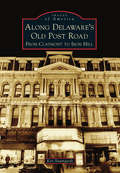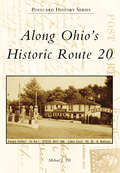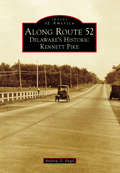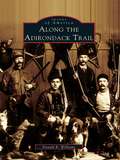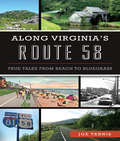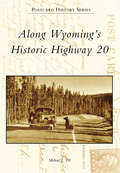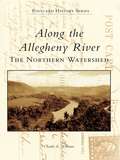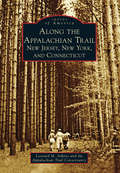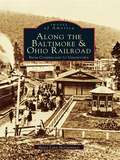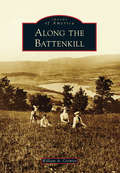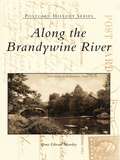- Table View
- List View
Alma
by David McmackenRalph Ely, founder of Alma, selected 10 acres of old forest on the bank of the Pine River in 1853. In this central-Michigan wilderness, he built a log cabin, a log store, and two steam-powered mills--a sawmill and a gristmill. At first, his growing settlement was called Elyton, but within a few years, it was renamed Alma, memorializing a battle in the Crimean War. Alma was energized by the acquisition of millionaire lumberman and entrepreneur Ammi W. Wright, who poured his resources into the town. Wright encouraged the establishment of Alma College in 1886 and the state Masonic home for the elderly in 1911. Wright laid the foundations for Alma's great Republic Truck Company, the largest exclusive maker of trucks in the world by 1920. The discovery of several oil fields prompted the establishment of two oil refineries in Alma in the 1930s and saved the town from the doldrums of the Great Depression. By the 1950s, Alma was a key national manufacturer of house trailers and mobile homes. This photographic panorama reflects the city's economic cycles and its institutions that have given Alma an enviable stability through the years.
Almost American Girl: An Illustrated Memoir
by Robin HaHarvey Award Nominee, Best Children or Young Adult Book A powerful and moving teen graphic novel memoir about immigration, belonging, and how arts can save a life—perfect for fans of American Born Chinese and Hey, Kiddo. <p><p>For as long as she can remember, it’s been Robin and her mom against the world. Growing up as the only child of a single mother in Seoul, Korea, wasn’t always easy, but it has bonded them fiercely together. So when a vacation to visit friends in Huntsville, Alabama, unexpectedly becomes a permanent relocation—following her mother’s announcement that she’s getting married—Robin is devastated. <p><p>Overnight, her life changes. She is dropped into a new school where she doesn’t understand the language and struggles to keep up. She is completely cut off from her friends in Seoul and has no access to her beloved comics. At home, she doesn’t fit in with her new stepfamily, and worst of all, she is furious with the one person she is closest to—her mother. Then one day Robin’s mother enrolls her in a local comic drawing class, which opens the window to a future Robin could never have imagined. <p><p>This nonfiction graphic novel with four starred reviews is an excellent choice for teens and also accelerated tween readers, both for independent reading and units on immigration, memoirs, and the search for identity. <P><P><i>Advisory: Bookshare has learned that this book offers only partial accessibility. We have kept it in the collection because it is useful for some of our members. Benetech is actively working on projects to improve accessibility issues such as these.</i>
Almost Anywhere: Road Trip Ruminations on Love, Nature, National Parks, and Nonsense
by Krista SchlyerWhat do you do when your world ends? At twenty-eight years old, Krista Schlyer sold almost everything she owned and packed the rest of it in a station wagon bound for the American wild. Her two best friends joined her--one a grumpy, grieving introvert, the other a feisty dog--and together they sought out every national park, historic site, forest, and wilderness they could get to before their money ran out or their minds gave in. The journey began as a desperate escape from urban isolation, heartbreak, and despair, but became an adventure beyond imagining. Chronicling their colorful escapade, Almost Anywhere explores the courage, cowardice, and heroics that live in all of us, as well as the life of nature and the nature of life. This eloquent and accessible memoir is at once an immersion in the pain of losing someone particularly close and especially young and a healing journey of a broken life given over to the whimsy and humor of living on the road.
Almost Lost Arts: Traditional Crafts and the Artisans Keeping Them Alive
by Emily FreidenrichThis book is a celebration of tactile beauty and a tribute to human ingenuity. In-depth profiles tell the stories of 20 artisans who have devoted their lives to preserving traditional techniques. Gorgeous photographs reveal these craftspeople's studios, from Oaxaca to Kyoto and from Milan to Tennessee. Two essays explore the challenges and rewards of engaging deeply with the past. With an elegant three-piece case and foil stamping, this rich volume will be an inspiration to makers, collectors, and history lovers.
Almost Nothing: Reclaiming Edith Farnsworth
by Nora WendlThe iconic Edith Farnsworth House is a singular glass home designed by Mies van der Rohe. But the oft-told history of the house overwrites Farnsworth’s role as Mies’s collaborator and antagonist while falsely portraying her as the architect’s angry ex-lover. Nora Wendl’s audacious work of creative nonfiction explodes the sex-and-real-estate myth surrounding the Edith Farnsworth House and its two central figures. An eminent physician and woman of letters, Farnsworth left a rich trove of correspondence, memoirs, and photographs that Wendl uses to reconstruct her voice. Farnsworth’s memories and experiences alternate with Wendl’s thoughts on topics like misogyny and professional ambition to fashion a lyrical examination of love, loneliness, beauty, and the search for the divine. Eloquent and confessional, Almost Nothing restores Edith Farnsworth to her place in architectural history and the masterpiece that bears her name.
Almost Nothing: The 20th Century Art And Life Of Józef Czapski
by Eric KarpelesA compelling biography of the Polish painter and writer Józef Czapski that takes readers to Paris in the Roaring Twenties, to the front lines during WWII, and into the late 20th-century art world.Józef Czapski (1896–1993) lived many lives during his ninety-six years. He was a student in Saint Petersburg during the Russian Revolution and a painter in Paris in the roaring twenties. As a Polish reserve officer fighting against the invading Nazis in the opening weeks of the Second World War, he was taken prisoner by the Soviets. For reasons unknown to this day, he was one of the very few excluded from Stalin’s sanctioned massacres of Polish officers. He never returned to Poland after the war, but worked tirelessly in Paris to keep alive awareness of the plight of his homeland, overrun by totalitarian powers. Czapski was a towering public figure, but painting gave meaning to his life. Eric Karpeles, also a painter, reveals Czapski’s full complexity, pulling together all the threads of this remarkable life.
Almost Perfect: The Life Guide to Creating Your Success Story Through Passion and Fearlessness
by Erika LemayThrough Almost Perfect, Erika Lemay shares how she became world-famous by creating a career out of her passion — the acrobatic world of Physical Poetry. The gritty detail of a life in the spotlight is exposed — rebuilding herself after a fall that left one of her limbs compromised and challenged all she had aspired to be, avoiding child abusers in the show business world, and keeping her cool when the unpredictable happens 30 metres in the air. More than this, Erika explains the methodology behind her success stories. With precise parameters, tips, and tricks, Almost Perfect is the guide she shares to a pain-free life, which explains how she maintains her physical conditions to Olympic-athlete level, and demonstrates how everyone can achieve the extraordinary — not by magical thinking but by designing a precise set of habits that can open doors to what most think is only accessible to the few. Almost Perfect is ideal for anyone that aspires to exceptional health, an extraordinary life, a head-turning physique, and an enviable career. Erika’s carefully crafted methodology for excelling at specific goals is laid bare for the world to see. Nothing comes for free: a detail-oriented and elite mindset is the key to the most incredible life-changing path. Throughout Almost Perfect, readers learn to be the incarnation of coherence through iron discipline and unshakeable self-worth.
Along Chautauqua Lake (Postcard History Series)
by Dorothy E. Levin Karen E. LivseyShortly after settlement began along Chautauqua Lake, steamboats furnished transportation and the first hotel catered to visiting hunters and fishermen. Families escaping the summers in the city soon followed to enjoy the cool, healthy air. Chautauqua Institution and Point Chautauqua both began as religious assembly grounds. Celoron Park, often called the "Coney Island of the West," and later Midway Park provided entertainment for families and attracted thousands of visitors who traveled by trolley and steamboat in the summer. Local residents and visitors alike enjoyed the parks, picnic groves, and assorted resorts along the lake. A century later, fish are still caught, boats still ply the waters, and families continue to enjoy everything Chautauqua Lake has to offer.
Along Delaware's Old Post Road: From Claymont to Iron Hill
by Ken BaumgardtAlong Delaware's Old Post Road: From Claymont to Iron Hill snakes through the Colonial towns of Claymont, Wilmington, Newport, Stanton, Christiana, and the Pencader Hundred portion of northern Delaware. This 13-mile route has different names, from Philadelphia Pike to Maryland Avenue to Old Baltimore Pike, but it is along this road that the State of Delaware has its earliest roots. The photographs of the people and places are mostly misty memories as the route grew from a narrow dirt road to a modern four-lane thoroughfare. From Cooch's Bridge at one end, where the only battle on Delaware soil was fought, to Archmere Academy at the northern end, the corridor has a largely forgotten place in history. Travelers now trace the same route once traversed by George Washington, Thomas Jefferson, and Charles Mason and Jeremiah Dixon as they rode into history.
Along Iowa's Historic Highway 20
by Michael J. TillUS Highway 20 was designated a federal highway in 1926. For the first half of the 20th century, it was the most important east-west road across northern Iowa, extending from the Mississippi to the Missouri River. The road connected 13 counties, four major metropolitan areas, and many smaller communities along its route. Fortunately, the historic two-lane road remains almost completely intact and can be driven much as travelers did in years gone by. Along Iowa's Historic Highway 20 celebrates such a trip, illustrated by more than 200 antique postcards that show the personality of the road: town and city scenes, rural vistas, rivers, bridges, and historic sites. Not to be forgotten are the tourist courts, hotels, diners, and gas stations that made travel possible.
Along New York's Route 20 (Postcard History Series)
by Michael J. TillFew roads can match Route 20's beauty, history, or contribution to New York's vitality. In 1926, Route 20 became a federal highway and evolved into New York's foremost east-west road. But unlike most early highways, it has survived almost completely intact. The story of Route 20 is told through more than 200 vintage postcards showing scenes from the Shaker communities in Columbia County to the Lake Erie Shore. The postcards show the personality of the road: main streets, the Finger Lakes, and scenic vistas. Not to be forgotten are the tourist courts, hotels, diners, and gas stations that made travel possible.
Along Ohio's Historic Route 20 (Postcard History Series)
by Michael J. TillRoute 20 was named a federal highway in 1926, and for the first half of the 20th century it was the most important east-west road across northern Ohio. Extending from the Pennsylvania border east of Conneaut to its western terminus with Indiana, it made Ohio the connecting link between Northeastern and Midwestern states. Fortunately, Route 20 has remained virtually intact and can be traveled much as people did in years past. Postcard History Series: Along Ohio's Historic Route 20 celebrates such a trip, illustrated by more than 200 vintage postcards depicting views along the way. Town and city scenes, rural vistas, and historic sites that drew early motorists to the highway are featured. Not to be forgotten are the tourist courts, hotels, diners, and gas stations that made automobile journeys possible.
Along Route 52: Delaware's Historic Kennett Pike (Images of America)
by Andrew D. EngelCreated through an act of the Delaware Legislature in 1811, the Wilmington and Kennett Turnpike would become one of the most important roads in New Castle County. Linking the city of Wilmington, Delaware, to Kennett Square, Pennsylvania, it would become crucial in the transportation of goods from a growing industrial Wilmington to Philadelphia and the eastern counties of Pennsylvania. Kennett Pike, as it would come to be known, operated as a toll road until it was purchased in 1919 by industrialist Pierre S. du Pont (1870-1954). Du Pont would work over the next year and a half to widen and modernize the highway and eliminate its tolls. When work was completed, he sold the road back to the state for just $1. Kennett Pike has continued to grow through the 20th century, with dozens of private estates gracing its borders. Villages such as Greenville and Centreville have been characterized by their country charm and local businesses, including Shields Lumber & Coal and Buckley's Tavern.
Along Route 6 in Massachusetts (Postcard History Series)
by James A. GayRoute 6 in Massachusetts runs from Provincetown to Seekonk and passes through some of the most beautiful scenery in the state. What had once been a mere footpath for Native Americans, then widened for the use of stagecoaches, Route 6 would be officially designated the “King’s Highway” in 1920. The moniker was extremely unpopular with the local residents, so much so that the governor officially changed the name to the Grand Army of the Republic Highway in 1937. Depicted from the author’s personal collection of postcards from the 1920s to the 1960s, Route 6 winds its way around tiny fishing villages, sand dunes, marshes, beaches, lighthouses, campgrounds, hotels, restaurants, and historic cities. The combination of Route 6 and the automobile would make Cape Cod a world-renowned tourist destination.
Along The Adirondack Trail
by Donald R. WilliamsNative Americans called the area Couxsaxrage, "beaver hunting ground." Professor Ebenezer Emmons named it Adirondack, after one of the native tribes. Along the Adirondack Trail traces the history and lore of the Adirondacks up the scenic roadway through the heart of New York's mountain-and-lake country. Included are tales of the Mohawk Indians and their beatified princess, Tekakwitha; the site of the mansion of Sir William Johnson, one of America's most influential citizens of the 1700s; and an important battleground of the Revolution. Rare original photographs portray each of the twenty settlements on the trail from Fonda to Malone, reflecting the lives of the guides, loggers, trappers, sportsmen, camp owners, tourists, leather workers, and health seekers who opened up the unknown county.
Along Virginia’s Route 58: True Tales From Beach to Bluegrass (History And Guide Ser.)
by Joe TennisRoute 58 stretches across all five hundred miles of Virginia, from the sandy shores of the Atlantic to the waterfalls and wild ponies of the Blue Ridge Highlands. Weird, quirky and intriguing legends and lore lie along this historic highway, including a UFO landing in South Hill, Virginia Beach's "witch duck" controversy of 1706 and Nat Turner's bloody insurrection in 1831. Country music icon Johnny Cash played his final shows at the world-famous Carter Fold. Civil War skirmishes touched towns. The "Wreck of the Old 97" happened in Danville, and haunting memories of a schoolhouse lost to a tornado remain in Rye Cove. Author Joe Tennis provides a guide to Route 58 with a trail of tales, accompanied by easy driving directions and vivid photography.
Along Wyoming's Historic Highway 20 (Postcard History)
by Michael J. TillHighway 20 was designated a federal highway in 1926, and until the arrival of the Interstate Highway System in the 1950s it was a primary route across northern Wyoming. From the Great Plains in the east to the mountains in the west, Highway 20 passed though cities and towns that retain their frontier visages and such wonders as Hell's Half Acre, the Wind River Canyon, Natural Hot Springs, Buffalo Bill Scenic Byway, and spectacular Yellowstone National Park. Fortunately, historic Highway 20 remains almost completely intact and can be driven much as travelers did in years past. Postcard History Series: Along Wyoming's Historic Highway 20 celebrates this trip, illustrated by more than 200 vintage postcards showing the personality of the road. Not to be forgotten are the tourist courts, hotels, diners, and gas stations that made automobile travel possible.
Along for the Ride
by Rachel MeinkeThe worst summer of her life has one seriously hot perk . . .These days, everything in Katelyn Jackson’s life revolves around her pop star brother. His schedule, his tour, his fans—it’s like Connor Jackson’s become the center of the universe. And when the entire family decides to join Connor’s tour, Katelyn has to kiss her soccer team, her friends—and her entire summer—goodbye.The only good news is the opening act is none other than her favorite band with the hottest lead singer ever. Zach Matthews, with his deep caramel eyes, makes Katelyn’s heart pound a zillion beat per minute. Don’t mind me, I’m just fangirling over here.Between the endless bus rides and cruddy room service, some serious chemistry develops between Katelyn and Zach. But as they say, all is not fair in love and pop stardom and Katelyn will have to decide if she’s willing to take a risk or if she’s just along for the ride.
Along the Allegheny River: The Northern Watershed
by Charles E. WilliamsThe Allegheny River, of western Pennsylvania and New York, flows through a region rich in natural resources and human history. While the river is 320 miles long, the northern watershed district originates in Potter County, Pennsylvania, and joins the Clarion River near Parker, Pennsylvania. Along the Allegheny River: The NorthernWatershed showcases over 200 vintage postcards of the river, its landscape, and its people. These captivating images chronicle over 200 years of history, from the French and Indian War to the timber and oil booms of the late 19th and early 20th centuries.
Along the Allegheny River: The Southern Watershed
by Charles E. WilliamsThe Allegheny River of western Pennsylvania and New York rises in Potter County, Pennsylvania, and flows 320 miles to its confluence with the Monongahela River in Pittsburgh. The Allegheny's southern watershed district begins in East Brady, Pennsylvania, and ends in Pittsburgh, and it includes the historic Redbank Creek, Mahoning Creek, Crooked Creek, and Kiskiminetas River valleys. Along the Allegheny River: The Southern Watershed features over 200 vintage postcards of the landscapes, people, industries, and events that shaped the history of the southern Allegheny River Valley and of the nation. These absorbing images chronicle over 200 years of history from the frontier wars of the 18th century to the rise and growth ofthe Industrial Revolution in the late 19th and early 20th centuries.
Along the Appalachian Trail: New Jersey, New York and Connecticut
by Leonard M. Adkins Appalachian Trail ConservancyCrossing through 14 states from Maine to Georgia, the Appalachian Trail enters New Jersey through the Delaware Water Gap, crosses New York's Hudson River, and rises over Connecticut's Lion's Head. The area is considered by some to be the pathway's birthplace, for in 1923, just two years after Benton MacKaye originally proposed the trail, the first few miles specifically constructed for the Appalachian Trail were built by volunteers in New York's Harriman and Bear Mountain State Parks. These photographs and the corresponding narrative present a historical perspective on what it took to create the trail, including the thousands of volunteers and the arduous tasks they performed, those who lived along the trail before and during its creation, the many people who have enjoyed the trail through the years, and the original routes that are no longer part of the present-day Appalachian Trail.
Along the Baltimore & Ohio Railroad: From Cumberland to Uniontown (Images of America)
by Marci Lynn McguinnessDuring the turn of the century, the railroad was anextremely important transportation and shipping resource to thousands of people and businesses inPennsylvania. Along the Baltimore & Ohio Railroad:From Cumberland to Uniontown dedicates its pages to this mass transportation provider. This book includes images from every B&O bridge and station from Cumberland, Maryland, to Uniontown, Pennsylvania, in 1891. Many of the towns stretched along the miles of tracks, such as Somerfield and Ohiopyle, are depicted in these vintage photographs. Experience the coal and coke booms of the 1880s to 1920s through people from many different locations who had one thing in common: the railroad.
Along the Battenkill (Images of America)
by William A. CormierThe Battenkill Valley, in the southern part of Washington County, is the historical backdrop to many homesteading settlers as well as the Mohawk and Mahican tribes. Two retired Roger's Rangers, James Turner and Joshua Conkey, came to Salem and purchased 25,000 acres of land--known as the Turner Patent--bringing many families from Pelham, Massachusetts, to settle along White Creek and the Battenkill. With the advent of photography, the results of this pioneering spirit were captured, first on glass negative plates and later with roll film, by numerous Salem photographers from 1865 to the early 1900s. As new canals, roads, and railroads of the 1800s were built, local photographers could travel easily with their heavy photography equipment, capturing scenes of the towns and villages nestled in the Adirondack Mountains, replete with their own rivers and lakes. Now, the region thrives off agriculture, logging, mining, and tourism. The Battenkill draws hundreds of fishermen, boaters, and swimmers to the area in the spring and summer.
Along the Brandywine River
by Bruce Edward MowdayThis fascinating new history of the historical river that winds through Chester County, Pennsylvania, and the upper regions of Delaware and emptying into the Christina River in Wilmington, Delaware, showcases more than two hundred of the best vintage postcards available. The collected postcards show the countryside as it appeared during the Revolutionary War Battle at Brandywine through the time of nineteenth-century settlements in the region and into the twentieth century.
Along the Bucktail Highway
by Charles E. WilliamsThe Bucktail Highway, Pennsylvania Route 120, traverses over 100 miles of the commonwealth's historic northern tier, linking Ridgway in the west with Lock Haven in the east. The Bucktail Highway crosses the eastern continental divide east of St. Marys and closely follows the picturesque, deep valleys carved by Sinnemahoning Creek and the West Branch of the Susquehanna River. Originally a Native American path and later a road that carried settlers west beyond the Allegheny Front, today's Bucktail Highway is a centerpiece of the Pennsylvania Wilds, a public-private initiative to promote and conserve the unique natural and historic resources of the region. Along the Bucktail Highway showcases over 200 vintage postcards profiling the cultural and natural history of the towns, forests, and waters linked by this scenic route from its beginnings as a westward trail, its growth as a commercial and industrial corridor in the late 1800s and early 1900s, and its recent emergence as a premier Pennsylvania scenic byway.
